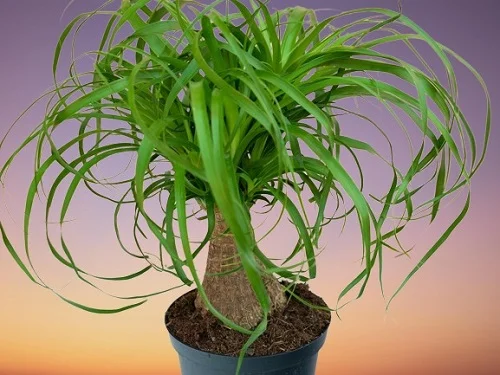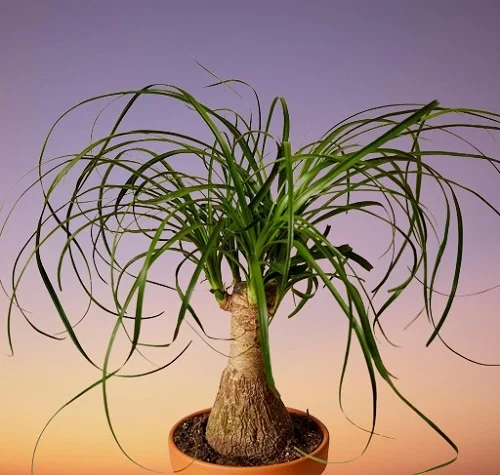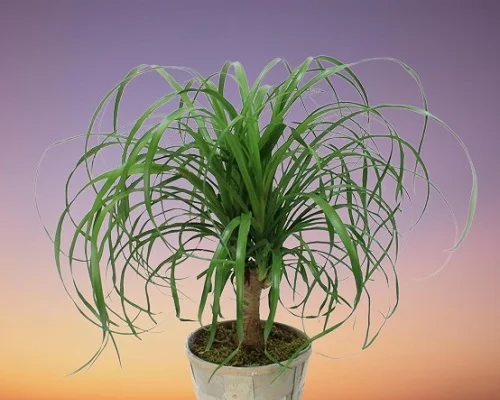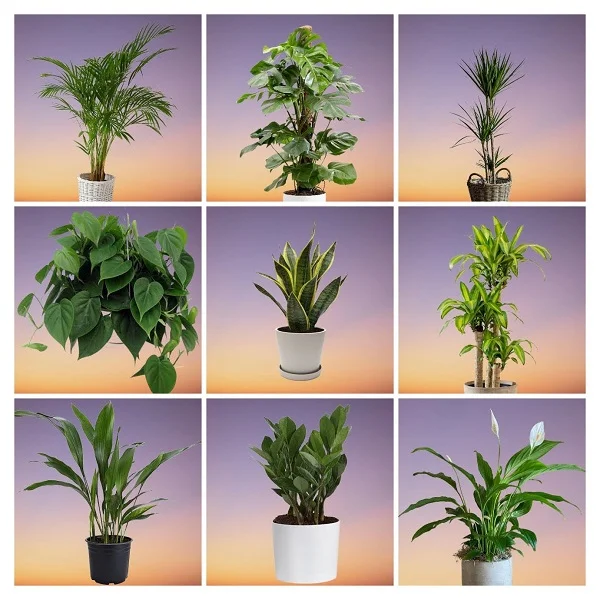Beaucarnea recurvata (Ponytail Palm) Care Indoors, Propagation, Problems and Remedies
Some links in this post may be affiliate links
Beaucarnea recurvata (Ponytail Palm) prefers bright light with some direct sunlight, average warmth, moderate humidity and moderately moist, rich, well-drained soil coupled with monthly feeding in the growing season.
Ponytail Palm also called Elephant Foot Plant is one of the popular hardy plants that is easy to grow indoors as it does not require a lot of attention making it ideal for a beginner or the forgetful plant parent.
Beaucarnea recurvata is a slow-growing, succulent plant with a large, swollen bulb that stores water which resembles an elephant's foot and hence the common name 'Elephant Foot'. This places this plant among the best plants with low water needs.
A thin trunk arises from the swollen bulb and is topped by a plume of long strap-like leaves which give this plant its common name 'Ponytail Palm'.
Though called a palm, Beaucarnea recurvata is not a true palm. It is a member of the Asparagaceae family along with Spineless Yucca (Yucca gigantea), ornamental Asparagus plants and Spider plants (Chlorophytum comosum).

Botanical name: Beaucarnea recurvata
Family: Asparagaceae
Common names: Ponytail Palm, Elephant Foot Plant
Origin
Beaucarnea recurvata is native to the states of Tamaulipas, Veracruz and San Luis Potosi in eastern Mexico.
How big will a Ponytail Palm get?
Under the right conditions Ponytail Palm can grow to a height of 6 feet or more. The strap-like leaves can be as long as 6 feet and about 2 inches wide which makes this plant one the large-leafed plants that make a bold statement in any space.
Is Beaucarnea recurvata toxic?
No. Beaucarnea recurvata is non-toxic to both humans and pets as indicated by ASPCA. It is among the pet safe plants that you may grow in the home.
Where to Buy
If you are looking to add Ponytail Palm to your collection, you may acquire these plants online from Etsy (Link to Etsy).
How to care for Beaucarnea recurvata Indoors
To care for Beaucarnea recurvata indoors, provide bright light 4-6 hours of direct sunlight, warmth of 50-55%, humidity of 50-55% and moderately moist, rich, well-drained soil coupled with monthly feeding during the growing season.
Ponytail Palm needs pruning to keep the plant neat as well as minimize pest and disease infestations. Repotting is necessary when the plant becomes extremely pot-bound. Keep reading for more on these growing conditions and how to provide them.

Watering
How often do you water Ponytail Palm?
Water your Ponytail Palm liberally in spring and summer while allowing the top 2-3 inches of soil to dry out between waterings. Keep the soil moderately moist and avoid overwatering to prevent rotting and yellowing.
Cut down on watering in fall and winter to keep the soil slightly moist as growth is reduced at this time. Do not allow the soil to dry out completely to prevent wilting and drooping leaves.
Use water that is at room temperature to prevent cold shock which can result in reduced growth and leaf drop. Ensure that the water is chlorine-free to avoid browning of leaf edges.
Make sure that the soil is free-draining and the pot has a drainage hole to prevent the soil from getting soggy as it can lead to rotting of the bulb.
Light Requirements
Do Ponytail Palms need direct sunlight?
Yes. Beaucarnea recurvata grows best in bright light with at least 4-6 hours of direct sunlight, however, protect it from hot midday sunshine as it can cause scorching of the leaves.
Elephant Foot can also tolerate direct sunshine. However, it needs to be acclimatized before moving it under direct sunlight to avoid sunscorch marks on the leaves.
Too little light for Ponytail Palm will result in stunted growth and yellowing of leaves. Therefore, if the natural lighting is not sufficient, use a full spectrum grow light to supplement it.
Rotate the pot regularly to ensure that the plant receives light on all sides for even growth and prevent lopsided growth.
Temperature & Humidity
Ponytail Palm thrives in an average warmth of 18-280C. Room temperatures that are comfortable for you are ideal for this plant. Keep it away from drafts emanating from AC units, hot stoves, windy doors, drafty windows and others to prevent stunted growth.
Beaucarnea recurvata flourishes in a room humidity of 50-55%; it has no need for extra humidity. However, if the air is too dry especially when the indoor temperatures are high, you may use a cool mist humidifier to raise humidity.
Potting Medium
The best potting mix for Ponytail Palm should be rich in organic matter, loose and free-draining to avoid getting soggy soil. The soil should be loose enough to allow water to drain out fast enough as the plant is prone to root-rot disease. A cactus and succulents soil is ideal for this plant as it drains easily.
Fertilizer
Feed Beaucarnea recurvata with a balanced, liquid fertilizer every 4 weeks in spring and summer to boost growth.
Do not feed in fall and winter as growth is minimal and feeding at this time may lead to fertilizer burn.
Repotting
Repot Beaucarnea recurvata during the growing season only when the plant has become extremely pot-bound as it grows best when slightly root-bound.
The best pot should allow 1 inch of space between the plant's trunk and the rim of the pot. Ensure that the trunk remains at the same soil level as it was in previous pot and that the bulbous part is not covered under soil to avoid rotting.
Confirm that the pot has a drainage hole and the soil is well-draining to prevent waterlogging which can lead to rotting. Check out these succulents pots available on Amazon.
Refresh the soil for the large plants by replacing the top 2-4 inches of soil with fresh soil. Take care not to injure the bulb and the roots.
Pruning & Grooming
How to prune Ponytail Palm?
Prune Ponytail Palm by removing dead and dry leaves to maintain the plant neat and also reduce pest and disease infestations. Avoid wounding the trunk as it can result in fungal infections.
Clean the leaves by damp-wiping with a soft cloth to get rid of dust as well as discourage pests and disease infestations.
Beaucarnea recurvata Propagation Guide
Beaucarnea recurvata (Ponytail Palm) is not easy to propagate but can be propagated from offsets (pups). The best time to propagate is at the beginning of the growing season (spring to early summer) when in active growth to hasten establishment.
Propagating Ponytail Palm from offshoots (pups)
- Allow the pups to grow to a length of about 4 inches or more to ensure the best chance of survival.
- Remove the soil around the base to expose where the pup joins the mother.
- With a sterilized, sharp knife, cut the pup away to separate it from the mother.
- Fill a small pot (1 inch wider than the base of the pup) one thirdway with a free-draining potting mixture which is sand-based to prevent rotting. Moisten the soil lightly.
- Position the pup in the center of the pot and cover the roots with the soil while firming the soil around the base.
- Cover the set up with a clear plastic bag to create humid conditions that are necessary for rooting.
- Keep the soil surface moist through out until the pup is well established.
- Once established, gradually over a period of 2 weeks remove the plastic cover after which you can begin routine care.

Beaucarnea recurvata Problems & Solutions
Beaucarnea recurvata (Ponytail Palm) are brown leaves, brown leaf tips, pests and diseases among others. Keep reading for more on these problems and how to fix them.
Brown leaves
Why are the leaves on my Beaucarnea recurvata turning brown?
The main causes of brown leaves on your Beaucarnea recurvata are inconsistent watering, temperature stress, direct sunlight, or aging.
How to fix it
Pull out the dry leaves to maintain the plant neat as new leaves grow from the top of the trunk.
Inconsistent watering: Do not water on a schedule. Water when the top 2-3 inches of soil dry. Never allow the soil to dry out completely.
Temperatute stress: Protect the plant from drafts originating from AC units, heat sources, windy doors and others.
Direct sunlight: Keep the plant away from hot direct sunlight or use a light curtain to filter the sunshine.
Aging: This is a natural process; as the plant matures the lower leaves turn brown and die.
Brown leaf tips
Brown leaf tips on Beaucarnea recurvata are caused by incorrect watering, fertilizer burn or temperature stress.
How to fix it
Snip off the brown tips with a sharp sterilized scissors to keep the plant neat.
Incorrect watering: Water the plant when the top 2-3 inches of soil dry out but do not allow the soil to dry out completely.
Fertilizer burn: The plant is a slow-grower and therefore does not require heavy feeding. Feed it monthly in spring and summer and withhold feeding in fall and winter.
Temperature stress: Keep the plant away from drafts to prevent sudden changes in temperatures.
Pests
Ponytail Palm is highly resistant to pests but weak plants can be attacked by scales, mealybugs and spider mites. Always ensure the plants are healthy at all times to minimize pest infestations.
How to fix it
- Isolate the affected plant to prevent spread to the other plants.
- Treat the plant with neem oil or an insecticidal soap. Ensure to follow the manufacturers' recommendations on the label.
- Regularly damp-wipe the leaves with a soft cloth to discourage the pests.
- Maintain the plant well pruned to discourage the pests.
You liked it? Share on social media.
Related Content
Amazon Associates Disclosure
Homeplantsguide.com is a participant in the Amazon Services LLC Associates Program, an affiliate advertising program designed to provide a means for sites to earn advertising fees by advertising and linking to amazon.com.





